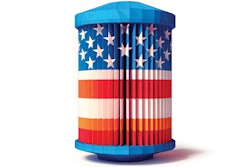
{bglink 3750}It’s one of the most familiar and trusted products in the pool industry, yet few people who use dichlor (sodium dichloro-S-triazinetrione) know much beyond the fact that it will kill algae, oxidize waste and provide an acceptable chlorine residual. This month’s Tech Notes provides some helpful detail.
Dichlor is typically sold in granular form, providing a simple and convenient way to chlorinate pools and spas. Dichlor is completely soluble in water and does not generate insoluble solids. Also, dichlor does not contribute to scaling, making it suitable for hard water.
Dichlor is available with additives that may provide some additional benefit to the user. However, it is important to note that if additives are mixed with the product, the available chlorine will be less than 56 percent or 62 percent. The available chlorine content is provided on product labels.
In addition to its use as a primary sanitizer, dichlor can perform additional water treatment functions to control algae and oxidize contaminants and chloramines. If the proper concentration of free chlorine (1 to 4 ppm) is maintained in the pool with dichlor, pool water will be properly sanitized — that is, the bacteria will be killed fast enough to control their populations in the pool water.
The free chlorine concentration for spas should be 2 to 5 ppm. The free chlorine generated from dichlor helps provide clear water by killing algae and by destroying organic matter that will cloud the water if allowed to build up. Chloramines, the most common cause of unpleasant odors, are also eliminated by the action of free chlorine.
Dichlor contains cyanuric acid, and when dichlor is used, 0.9 ppm of cyanuric acid is added to the water for each ppm of available chlorine added. A certain amount of cyanuric acid (usually within the range of 30 to 50 ppm) is necessary to protect the chlorine in outdoor pools from degradation by sunlight. When the recommended level of cyanuric acid is maintained, it enables the free chlorine to last three to four times longer than free chlorine in outdoor pools without cyanuric acid.
It’s important to remember that while it helps preserve the chlorine in a swimming pool, cyanuric acid also slows the oxidation of organics, kill rates of bacteria, viruses and algae. This has been demonstrated in controlled laboratory studies.
Cyanuric acid is a very stable molecule and does not readily degrade in swimming pools and spas. If the cyanuric acid level exceeds the APSP maximum of 100 ppm, it is recommended to perform a partial drain and refill. Draining has the advantage of removing contaminants that have built up through use of the pool or spa and is recommended as a periodic practice for all pools and spas to control the total dissolved solids.
RELATED: Chemical Basics: Cyanuric Acid
Application
The ways that dichlor products are used depend upon the purpose of application and the product form. The EPA-registered product label will have explicit use instructions that describe how to apply the material for specific application purposes. Dichlor is typically applied by broadcasting the product directly into the water.
The amount of product to be used or dispensed depends upon the specific application and the volume of water being treated. For example, in routine sanitizing use, the objective is to maintain a residual available chlorine (FAC) concentration of 1 to 4 ppm for pools and 2 to 5 ppm for spas. The label use instructions will explain how to determine a typical dosage for the water volume to be treated. Label use instructions will similarly define dosage requirements for other product applications such as oxidation, shock treatment or superchlorination.
The requirements for pool water testing in the application of dichlor based products should be indicated on the product label. The primary parameter to be tested is the level of FAC in the water. The choice of testing methods will vary depending on the type of pool (residential or commercial) and local regulations and standards. The product label should recommend that the pool water quality be properly balanced. This requires testing pH, alkalinity, calcium hardness and stabilizer (i.e., cyanuric acid).
Granular dichlor is often used to treat black algae that commonly grow in the cracks and crevices of the pool surfaces. Granular dichlor is acceptable for use in vinyl-lined pools for this purpose, provided the user follows the instructions provided on the product label.
Precautions
Dichlor is a dry solid with strong oxidizing properties. It is stable when stored in a cool, dry, ventilated area and not contaminated by other chemicals such as acids or easily oxidizable materials. Dichlor, in the solid form, shall not be mixed with other pool chemicals including other chlorinating agents. Partially empty packages must not be consolidated, as this could result in dangerous mixing with incompatible dry chlorinating agents having a similar appearance.
If mishandled, improperly stored or contaminated, dichlor products can become unstable and dangerous, as is the case in general with chlorinating agents. Fire, explosion and/or the emission of toxic gasses could result, depending on the nature and amount of the contaminant.
As with any oxidizer, dichlor can oxidize metals and may result in staining of pool and spa surfaces.







































